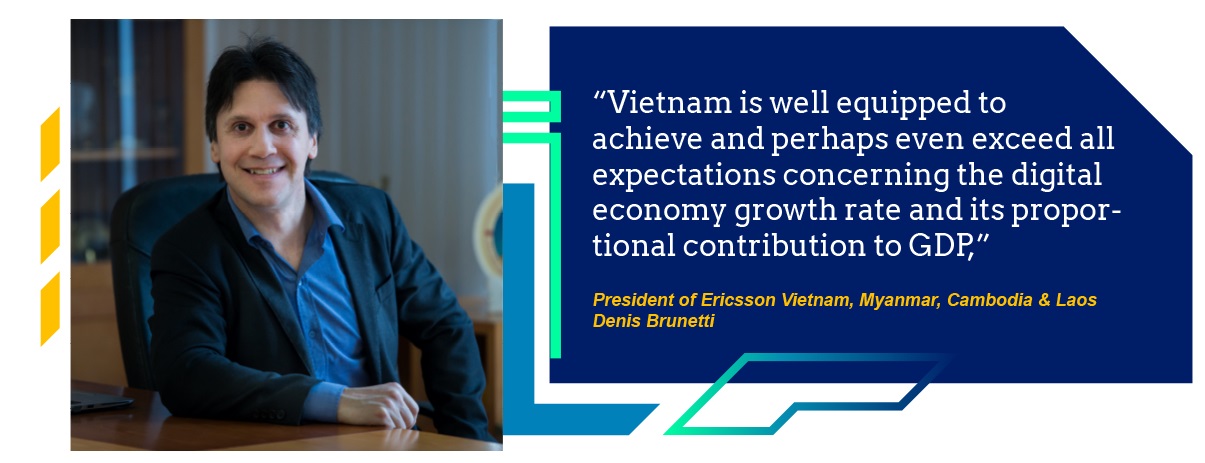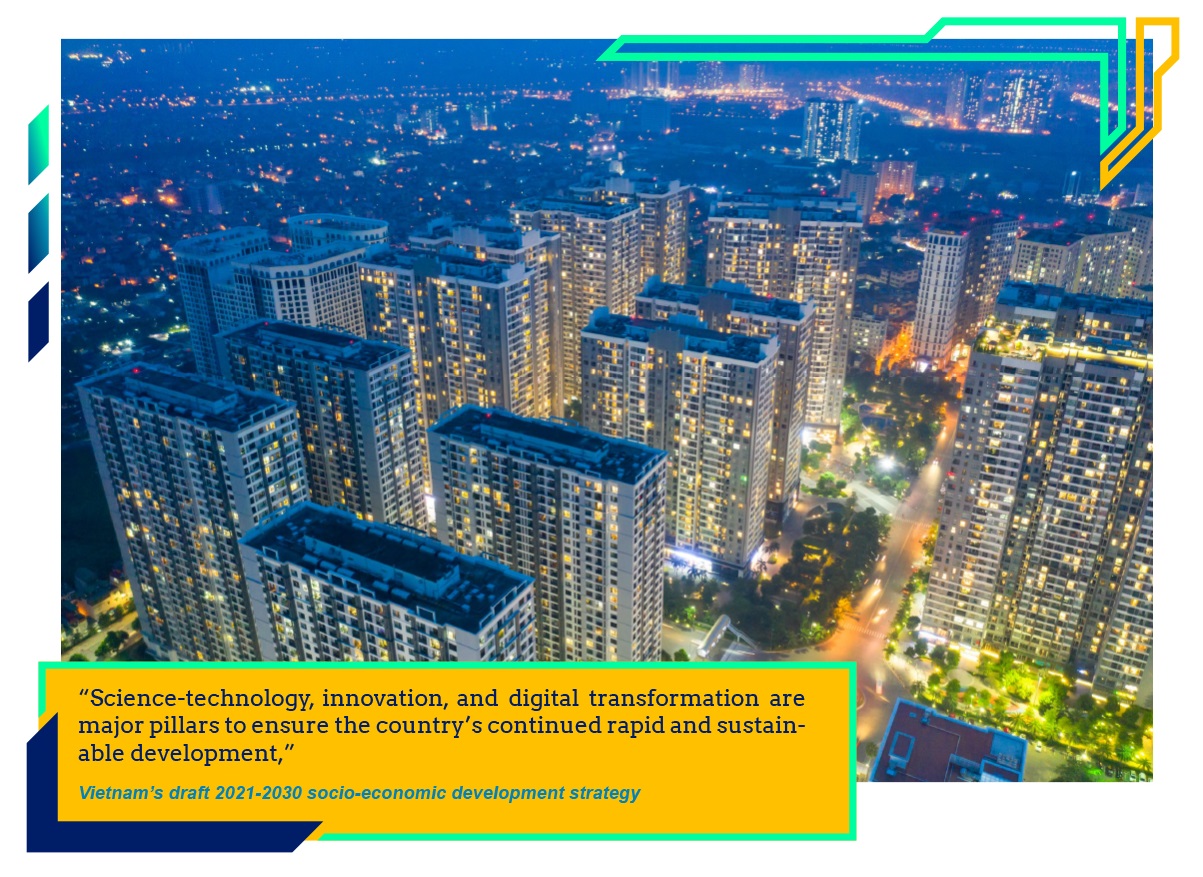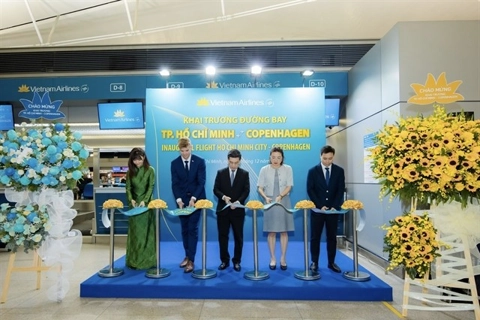5G carries Vietnam hope for future
Hanoi is among a few cities in Vietnam where people could come and see how the 5G network functions, as the city looks to provide 5G coverage in every industrial park, school, hospital, and tourist attraction by 2030.
Nguyen Hai Nam, 23, came to Hoan Kiem Lake in the city’s downtown to test the 5G for free, a promotional campaign provided by major network carriers since last year.
“This spot, along with dozen others around the city, are 5G demo places for testing Viettel and Vinaphone services. Those who want to try out the network simply need a 5G phone and send a text message 5GKM to 191,” Nam, who called himself a tech nerd, told The Hanoi Times.
“It takes me 30 seconds to download a video clip of 600MB, or 20MB per second, around three to five times the speed of 4G network, but I believe it would be much higher once the testing period is completed,” Nam said.
As localities like Hanoi or Ho Chi Minh City prioritizing the development of the digital economy and society to ensure sustainable development in the technological age, giving the people an opportunity to experience 5G is the right step towards that direction.
The 5G network is also widely seen as instrumental to revolutionize major economic sectors, especially in manufacturing and processing, and the Vietnamese Government is making sure to fully take advantage of this technology.
Since early this year, Yen Phong 1 Industrial Park in the northern province of Bac Ninh has become the first of its kind in the country gaining access to a 5G network as the country is aiming to ensure full 5G coverage in major industrial parks nationwide.
“The application of 5G in production would help lift productivity up and further attract investment capital into the province,” Vice-Chairman of the Bac Ninh Province People’s Committee Vuong Quoc stressed at the launching ceremony.
Sharing Quoc’s excitement, Vice Minister of Information and Communications Phan Tam expected unique features from 5G provided by local telco Viettel could accelerate the development of modern digital infrastructure in the province and meet the demand for the digital transformation of businesses.
“This network, given its extremely low latency rate, would lay the foundation for the pilot implementation of smart factories, as well and create an ecosystem of new services and apps for local enterprises,” Tam suggested.
Vietnam, a rather unfamiliar name in the tech world, is now among frontrunners on 5G development alongside the US, China, Japan, or EU. Such a feat shows the level of expectation that the people hold for this next-generation wireless technology system.
“Despite its low starting point, ours is the fifth country in the world capable of self-developing 5G equipment. But at the beginning, very few people both inside and outside the country had the belief that Vietnam could do it,” said Minister of Information and Communications Nguyen Manh Hung at a tech conference last November.
The statement is understandable as in fact, Vietnam was behind the rest of the world by seven to eight years in the deployment of 3G and 4G networks.
But lessons are learned the hard way, and Vietnam’s leading mobile carriers, including Viettel, MobiFone, and Vinaphone, are now at the center of the country’s push for 5G.
In May 2019, Viettel successfully tested the first phone call using 5G network in Vietnam, four months later, the carrier announced the pilot broadcasting of 5G network in Hanoi and Ho Chi Minh City.
MobiFone and Vinaphone followed the step as both announced 5G commercial trials in early 2020 with average speed during technical pilot deployment at 2.2 Gb per second, around the world’s standards for 5G network.
With such efforts, Vietnam mobile carriers were among 50 carriers from ten countries in the world in 5G deployment as reported from the Global System for Mobile Communications (GSMA) in September 2019.
Along with deploying a 5G network at the same pace as the world, Viettel had emerged among a handful of global players capable of developing 5G equipment and is considering equipment exports to 10 developing countries where it operates subsidiary carriers.
The country’s push for 5G did not go unnoticed with Nikkei in its article in 2019 saying the country is pursuing its own path, “while Thailand, the Philippines, and other countries lean toward Huawei.”
“Major Vietnamese telecom companies are seen to lean on proprietary […] to launch their 5G services,” it added.
In this regard, Director of Mobile Telecommunication of Mobile World Group Phung Ngoc Tuyen said local telecommunication companies have been preparing to get on the “5G train” by working on new smartphone models with 5G connectivity.
“However, the deployment progress of 5G would be the decisive factor to see whether these products could receive positive responses from the market,” Tuyen added.
Last July, VinSmart, a subsidiary of Vingroup, launched Vsmart Aris 5G - Vietnam’s first 5G smartphone, while CEO of Vietnam’s major IT firm BKAV Nguyen Tu Quang in a recent post on his personal Facebook page expected the next Bphone model would be integrated with 5G technology.
Experts suggested before being used widely in different fields, smartphones would help universalize 5G through promoting more mobile apps using virtual reality (VR) - augmented reality (AR), streaming of high-quality movies, or playing smoothly online games with a graphics-rich experience without any lagging.
According to Minister Hung, once the 5G network is rolled out on a large scale, Vietnam with locally-made 5G equipment would help save significant costs for both carriers and customers.
With the 5G trial already launched in certain areas in Vietnam in late 2020, President of Ericsson Vietnam, Myanmar, Cambodia & Laos Denis Brunetti told The Hanoi Times of his expectation for the services to start becoming widely deployed across the country by late 2021 or early 2022.
Deputy Director-General of Viettel Network Le Ba Tan, however, expected the deployment to last between 2023 and 2025, saying “it takes time and huge investment capital to build more 5G broadcast stations to ensure a smooth connection.”
“5G would first be deployed at major cities with a high density of population, or hi-tech parks, before being available in other areas,” Tan suggested.
Substantial investment costs, including those related to equipment and network management, would require mobile carriers to optimize operation for profitability.
From the customer's viewpoint, they would expect many improvements in internet speed but at affordable cost, which are also major challenges for businesses.
By 2021, Viettel Network estimated the country would have 1.5-2 million 5G broadband subscribers. A plus point in the 5G adaptation is that customers are not required to switch to 5G SIM as 4G-LTE SIM is sufficient, along with 5G-ready smartphones.
Vietnam’s pursuit of 5G is part of the country’s broader strategy for digital transformation, which offers a shortcut to catch up with developed economies that are also at the early phase of digitalization.
The 5G network, along with the Internet of Things (IoT), artificial intelligence (AI), Big Data, e-payment, cyber security, and e-authentication is fast becoming the core of the digital economy, society, and government.
Brunetti from Ericsson further stressed, “the availability of 5G networks, as the critical national digital infrastructure and enabling platform for innovation, digital transformation, and smart cities, is key and fundamental for enterprises and industries to fully leverage and benefit from the productivity and efficiency gains derived from digitalization.”
A study from the National Institute of Information and Communications Strategy (NIICS) suggested the contribution of 5G network for Vietnam’s GDP growth is around 7.34 percentage points by 2025, while the World Bank suggested a 10% increase in broadband penetration would trigger an average increase of 3.19% in per capita GDP.
It is not a coincidence that Vietnam’s draft socio-economic development strategy for the 2021-30 period identifies “science-technology, innovation, and digital transformation are major pillars to ensure the country’s continued rapid and sustainable development.”
“A new mindset is necessary to take advantage of the Industry 4.0 and the ongoing global integration process to restructure the economy, develop digital economy and society, with the main goals being higher productivity, quality, efficiency and competitiveness,” the strategy puts forward.
To realize the goal, the prime minister on June 3, 2020, approved the national digital transformation program until 2025, with a vision to 2030.
According to Hung, Vietnam is one of a handful of countries around the world having a specialized national program on digitalization.
“The program puts Vietnam at the same wavelength of other advanced countries in terms of awareness about digital transformation,” Hung said, adding this would create favorable conditions for Vietnam to fully grasp opportunities from Industry 4.0.
Among major goals set in the program, the digital economy is expected to make up 30% of the country’s GDP by 2030, a significant improvement from a modest 4% in 2020, or US$14 billion.
While it seems ambitious at first glance, Brunetti said this target “is very achievable”.
“When we reflect on the past several years, we can see that Vietnam’s digital economy is on an accelerated and exponential growth path towards this 30% of GDP goal in 2030,” he said, noting the country’s size of the digital economy is already in the top three within ASEAN - behind Indonesia ($44 billion) and Thailand ($18 billion).
“Through the visionary leadership and strategic focus by the Government of Vietnam is driving the ‘National Strategy on Industry 4.0’ and ‘Digital Transformation to 2025 and vision towards 2030’, Vietnam is well equipped to achieve and perhaps even exceed all expectations concerning the digital economy growth rate and its proportional contribution to GDP,” Brunetti concluded.




















